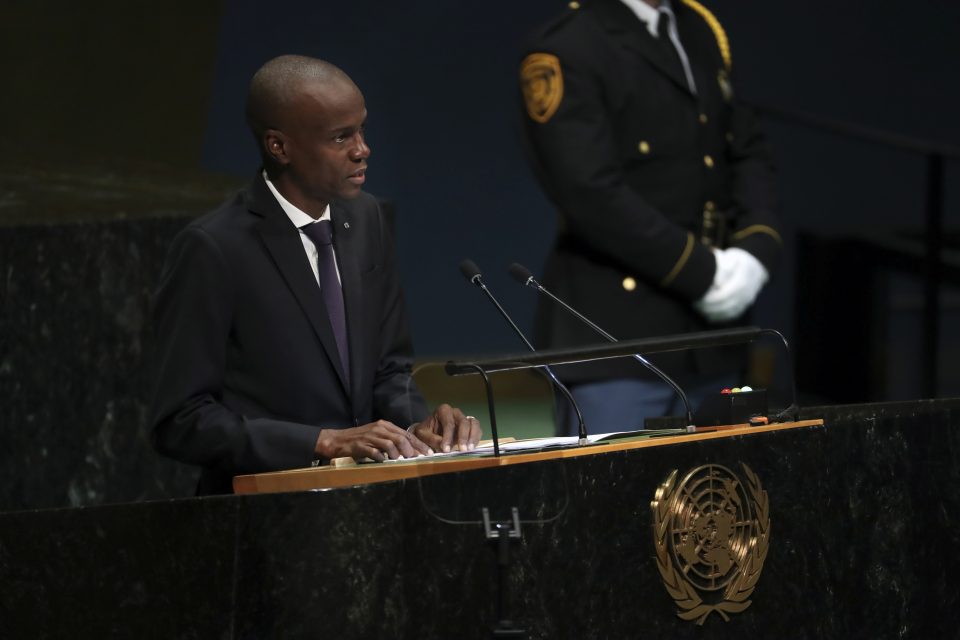At least 17 people, including 15 Colombians and two U.S. citizens, were detained in the assassination of President Jovenel Moïse, Haitian officials said Thursday night as they paraded the suspects before the news media and asserted that “foreigners” had been involved in the brazen attack.
At a news conference at National Police Headquarters with the interim prime minister, the American men were described as being of Haitian descent and were identified as Joseph Vincent and James Solages. Haitian security officials had earlier described Solages as a resident of South Florida who had been apprehended Wednesday during the manhunt for the assailants. A Canadian government official said that Solages was briefly employed as a reserve bodyguard by a security company hired by the foreign affairs ministry in 2010.
At least eight more suspects were on the run, authorities said.
“We are pursuing them. We are asking the public to help us,” said Haiti’s police chief, Léon Charles, before a phalanx of politicians and police.
Colombia’s defense minister, Diego Molano, said the government was cooperating with an official request from Interpol, the global police agency, for information about the detained suspects. He added that initial information suggests that they were retired members of the Colombian military.
The detainees were lined up at the news conference Thursday night in handcuffs, some showing signs of physical injuries. A table displayed at least 10 Colombian passports, along with automatic weapons, sledgehammers, and saws.
Haiti’s interim prime minister, Claude Joseph, said a group of foreigners had entered the country to kill the president “in a cowardly fashion.”
“They forgot something,” he said. “You may kill the president, but you cannot kill his dreams, you cannot kill his ideology, and you cannot kill what he was fighting for. That’s why I’m determined for President Jovenel Moïse’s family, friends, and allies, and the Haitian population, to get justice.”
Angry civilians have also joined in the hunt, capturing some suspects themselves and setting afire vehicles thought to have been used in the attack. Haiti is now basically under martial law after Joseph declared an “état de siège” — a state of siege — that allows the police and members of security forces to enter homes, control traffic, and take special security measures. It also forbids meetings meant to excite or prepare for the disorder.
The rapidly evolving crisis deepened the turmoil and violence that has gripped Haiti for months, threatening to tip one of the world’s most troubled nations further into lawlessness. Questions swirled about who might have been behind such a brazen attack and how they eluded the president’s security detail to carry it out.
There were reports of fighting between suspects and security forces throughout the day. Earlier Thursday, Helen La Lime, the top U.N. official in Haiti, told reporters that a group of suspects had “taken refuge in two buildings in the city and are now surrounded by police.” She spoke via teleconference from Port-au-Prince, after briefing the United Nations Security Council on the Haitian crisis in a private meeting. It was unclear if the situation had been resolved.
Haiti’s ambassador to the United States, Bocchit Edmond, has described the assailants as “well-trained professionals, killers, commandos.”
On Wednesday, security forces engaged in a chaotic shootout with a group of what they described as suspected assailants, though they offered no evidence linking them to the attack. Officers killed several in the group and took others into custody, authorities said.
Charles said Thursday that five vehicles that might have been used in the attack had been seized and that three of them had been burned by civilians. He said it was impossible for the police to gather evidence from inside the charred vehicles.
Social media was full of reports of civilians parading men with their arms tied behind their backs and men in the back of a police pickup truck.
A large crowd of people gathered in front of the police station in the Pétionville area of Port-au-Prince on Thursday morning, before Charles spoke, some demanding vigilante justice for the suspects they believed to be inside. “Burn them,” some cried.
Carl Henry Destin, a Haitian justice of the peace, said the president’s home had been peppered with holes and littered with bullet casings, and he had found the body of the president lying on the floor at the foot of his bed, “bathed in blood.”
“There were 12 holes visible in the body of the president that I could see,” Destin told The New York Times. “He was riddled with bullets.”
Moïse had been dressed in a white shirt and jeans, he said, both of which were torn and covered in blood. Bullet holes perforated his arms, hip, backside, and left ear. There was evidence of different caliber weapons being used, he said.
The president’s house had been ransacked, said Destin. “Drawers were pulled out, papers were all over the ground, bags were open,” he said. Two servants had been tied up, he said.
The president’s wife, Martine Moïse, was injured in the assault and was taken by air ambulance to the Ryder Trauma Center in Miami, where Joseph said she was “out of danger” and in stable condition. U.S. Rep. Frederica Wilson of Florida said at a news conference in Miami that Martine Moïse was not the target of the attack and that, according to the U.S. State Department, “she was caught in a crossfire.”
Wilson said the couple’s three children are in protective custody. Destin said that two of the children had been present during the attack and that they had hidden together in a bathroom.
This article originally appeared in The New York Times.


